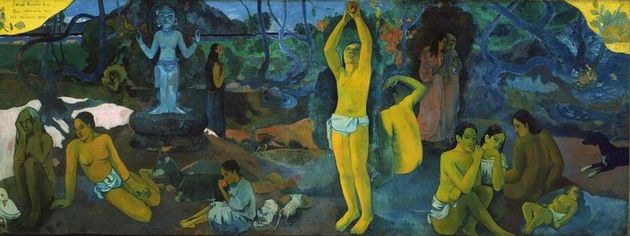Gauguin’s Blue
The painting portrays Gauguin’s struggle with the meaning of existence.
14 JULY 2018 · 18:00 CET

In 1891 Paul Gauguin sailed for Tahiti, in search of a civilization purer than his native France, and in 1897, after a month of feverish work, he completed his most eloquent painting.
Gauguin regarded this work of maturity as “his masterpiece and the summation of his ideas”, and named it Where do we come from? Who are we? Where are we going?
It is an impressive painting, culminating Gauguin’s post-impressionistic style which, similar to that of Van Gogh, uses colors and symbolism vividly, to depict not only an objective landscape but also the internal worldview of the artist.
The wide painting, indicated by Gauguin to be read from the right to the left, portrays a curious cycle of life: a newborn next to three women; a seated person inspecting his body, ahead of two weeping female figures; at the center, the only male character wears a simple loincloth and reaches up for an apple, symbol of exploration and of original sin, while a girl to his left eats an apple; until, after a few more figures, an old woman awaits her death in the far left.
The flow of life is watched by a blue idol, which represents “the Beyond” for Gauguin.
As the title suggests, the painting portrays Gauguin’s struggle with the meaning of existence. With his brushstrokes and inventive colors, Gauguin’s post-impressionism wanted to ask questions; he wanted to overcome in painting the mere depiction of reality, and to search for also “the mystery and the enigma of the great world in which we live”.
So here, with the baby and the attentive women on the right, Gauguin invites us to ask, “Where do we come from?” The mixture of exploration and sorrowful realization of the central characters portrays our quest for knowledge, “What are we?”
Finally, with the old woman watching the white dove, we cry out, “Where are we going?”

Notice one key detail: Gauguin portrays the religious idol in a blue similar to that of the sky, rocks and trees. It is a Beyond which is also infused in the landscape, an immanent transcendence, a wonder we feel not only at temples but also at the amphitheater of nature.
The idol is blue like the trees: our religion is natural, and nature is sacred.
Yet, almost before finishing the painting, Gauguin despaired, and attempted suicide with a dose of arsenic. But the dose was so heavy that he vomited it, ironically, and the poison did not reach his veins.
As Gauguin strived for the meaning of existence, neither the natural beauty of Tahiti nor the overpowering flush of creativity satisfied his soul. He immersed himself in an exotic civilization and in intimacy with nature, in his search for the Beyond, but he doesn’t feel close to it; by attempting suicide he places himself instead next to the aged woman, longing for death.
Gauguin’s “Beyond” was blue like the landscape, and this may have been the problem: it observes the cycle of life detached, passively, as a chameleon imprisoned in the cycle it is supposed to transcend.
It does not lie beyond the picture; it cannot answer our existential questions. It is arresting like nature in its mystic blue, but it is not more than that.
Curiously, Gauguin wanted to transcend nature in his art, but had not transcended it in his philosophy. His Beyond stands still within nature, and he leaves us with his characters, wondering without answers life’s ultimate questions.
Published in: Evangelical Focus - Culture Making - Gauguin’s Blue
